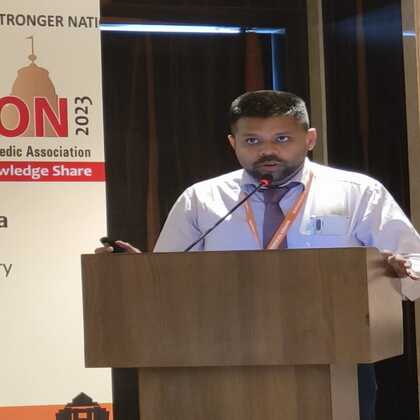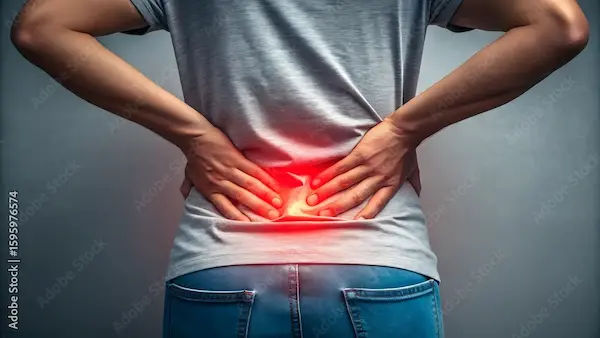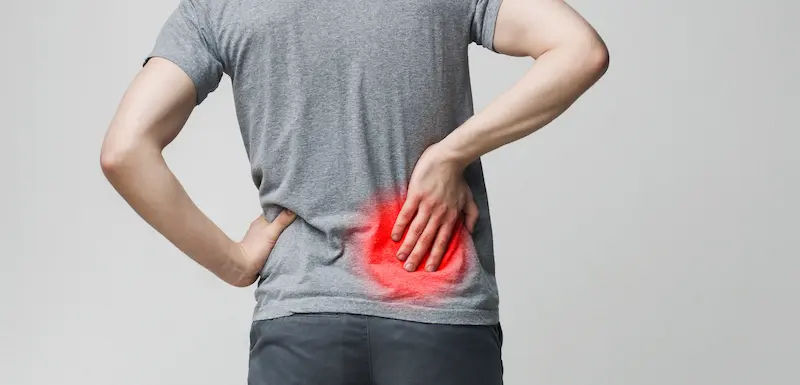Guide to Back Pain Sciatica Does Cold Weather Make Spine Problems Worse
Find effective, non-surgical ways to manage lower back pain caused by spinal arthritis. This guide covers physical therapy, medications, lifestyle changes, and other treatments for lasting relief.

Written by Dr. Rohinipriyanka Pondugula
Reviewed by Dr. Shaik Abdul Kalam MD (Physician)
Last updated on 25th Sep, 2025

Introduction: The Seasonal Ache - More Than Just a Coincidence
As the temperature drops and winter sets in, many people experience a familiar, unwelcome guest: a noticeable uptick in back pain and sciatica. If you find your lower back feeling stiffer, achier, or your sciatic nerve pain flaring up with the cold, you're certainly not imagining it. This phenomenon is widely reported, and there are solid scientific reasons behind why cold weather can exacerbate these conditions. This article delves deep into the connection between chilly climates and spinal discomfort. We'll move beyond the anecdotal and explore the physiological mechanisms—from barometric pressure changes to muscle behavior—that turn winter into a challenging season for those with back issues. More importantly, we will equip you with a practical, proactive action plan filled with strategies to manage pain, stay active, and take control of your spinal health. Whether you suffer from general back pain or the specific, shooting discomfort of sciatica, understanding this link is the first step toward a more comfortable winter.
Why Cold Weather Worsens Spine Problems?: The Science Behind the Stiffness
The link between cold weather and increased pain is not just in your head; it's rooted in how your body interacts with its environment. Several factors converge during colder months to create a perfect storm for discomfort, particularly for those already prone to back pain or sciatica.
The Barometric Pressure Puzzle: Your Joints as a Weather Barometer
Barometric pressure, or the weight of the atmosphere around us, often falls before and during cold, damp weather. Think of your body's tissues—including those around your spine and joints—as balanced systems. When the external pressure drops, the relative pressure inside your body can cause tissues to expand slightly. For inflamed areas, such as a arthritic joint or a swollen disc pressing on a nerve (a common cause of sciatica), this expansion can increase pressure on sensitive nerves, leading to a significant rise in pain perception. It's akin to a balloon expanding as it rises into lower-pressure air. While the change is subtle, for a sensitized nerve, it can be enough to trigger a flare-up.
Muscle Tension and Contraction: The Body's Natural Response to Cold
Your muscles react to cold by contracting and tightening—a process meant to generate heat and preserve core body temperature. This is why you shiver. However, this constant, low-level tension in the muscles surrounding your spine (the paraspinal muscles) can lead to stiffness and reduced flexibility. Tight muscles can pull on the spine, alter its alignment, and increase pressure on the spinal discs and nerves. For someone with sciatica, this muscular tension can further irritate the already-sensitive sciatic nerve, intensifying pain that radiates down the leg.
The Inactivity Trap: How Winter Makes Us Sedentary
Colder weather naturally discourages outdoor activities like walking, jogging, or gardening. This tendency toward hibernation leads to decreased physical activity. Muscles and joints thrive on movement, which pumps nutrient-rich blood to the areas and keeps them supple. When we become more sedentary, our core muscles weaken, and our spines lose the vital support they need. This deconditioning can make the spine more vulnerable to strain from even minor activities, like lifting a heavy grocery bag, leading to new or worsened back pain.
Consult a Orthopedic specialist for the best advice
Mood and Perception: The Mind-Body Connection in Pain
Less sunlight during winter can contribute to lower moods or Seasonal Affective Disorder (SAD). There's a well-established link between mood and pain perception. When we feel down or depressed, our perception of pain can be heightened. The psychological distress can lower our pain threshold, making existing back pain or sciatica feel more intense and harder to manage.
Sciatica vs. General Back Pain: Understanding the Difference
It's crucial to distinguish between general back pain and sciatica, as their causes and symptoms differ, even if both are affected by the cold.
What is Sciatica? The Nerve Pinch That Travels
Sciatica is not a diagnosis in itself but a symptom of an underlying problem, most commonly a herniated disc, spinal stenosis, or piriformis syndrome irritating the sciatic nerve. This nerve is the longest in your body, running from your lower back, through your hips and buttocks, and down each leg. The hallmark of sciatica is pain that radiates along this path. It's often described as a sharp, burning, or electric shock-like pain that travels, unlike general back pain, which is typically localized to the back. You might also experience numbness, tingling, or muscle weakness in the affected leg.
Is Sciatica More Sensitive to Weather Changes?
While both conditions can be aggravated by the cold, sciatica might be particularly sensitive due to the nerve component. Nerves are highly sensitive to pressure and inflammation. The combination of barometric pressure changes affecting tissue swelling and cold-induced muscle tension putting direct pressure on the nerve can make sciatica symptoms more volatile during weather shifts. Therefore, individuals with sciatica need to be especially diligent with their winter management strategies.
Proactive Strategies: Your Winter Action Plan for a Healthier Back
Instead of dreading the cold, you can take charge with these evidence-based strategies to minimize flare-ups.
Stay Warm, Stay Supple: Layering and Heat Therapy
The first line of defense is simple: stay warm. Dress in layers to maintain a consistent body temperature, paying special attention to your core and lower back. Consider thermal underwear or a supportive back warmer. Applying a heating pad or a warm bath can work wonders. Heat helps relax tense muscles, increases blood flow, and can reduce the sensation of pain. A warm shower in the morning can help "loosen up" a stiff back for the day ahead.
Keep Moving: Indoor Exercises to Combat Stiffness
Counteract the inactivity trap by establishing a consistent indoor exercise routine. Focus on: Low-Impact Cardio: Use a stationary bike or elliptical machine to get your blood pumping without jarring your spine.
- Core Strengthening: A strong core is a built-in back brace. Practice exercises like planks, bird-dogs, and bridges.
- Stretching: Gentle stretches for your hamstrings, hip flexors, and piriformis muscle can relieve pressure on your lower back and sciatic nerve. Yoga and Pilates are excellent options.
- Unique Insight: Instead of static stretching first thing in the morning when your muscles are coldest, try a brief 5-minute warm-up (like marching in place) followed by dynamic stretches (like leg swings) to prepare your body for movement safely.
Mind Your Posture: From Shoveling Snow to Binge-Watching
Winter brings unique postural challenges.
- Snow Shoveling: This is a major trigger for back injuries. Remember to bend at the knees, not the waist, and push snow rather than lifting it. Take frequent breaks.
- Sedentary Habits: If you're spending more time indoors sitting, ensure your workspace is ergonomic. Get up and move for a few minutes every 30-60 minutes to prevent stiffness. Use a lumbar roll to support the natural curve of your lower back.
When to Consult a Doctor?: Recognizing the Red Flags
While weather-related flare-ups are common, it's vital to know when your symptoms indicate a more serious issue. If your back pain or sciatica is severe, doesn't improve with rest and self-care after a week, or is accompanied by any of the following "red flag" symptoms, you should consult a doctor immediately:
- Loss of bladder or bowel control (cauda equina syndrome, a medical emergency).
- Significant weakness in your leg or foot.
- Numbness in the "saddle area" (around your genitals).
- Fever unexplained weight loss, or a history of cancer.
If your condition does not improve after trying these methods, book a physical visit to a doctor with Apollo24|7 for a thorough evaluation and personalized treatment plan, which may include physical therapy or other interventions.
Conclusion: Taking Control of Your Comfort in the Cold
The relationship between cold weather and spine problems is complex, involving physics, physiology, and behavior. However, by understanding the "why"—from barometric pressure drops to the temptation of inactivity—you are empowered to take proactive steps. You don't have to resign yourself to a season of pain. By prioritizing warmth, maintaining a consistent and thoughtful exercise regimen, and practicing good posture, you can significantly reduce the impact of winter on your back and sciatica. Remember, your spine's health is a year-round commitment. If your symptoms are persistent or concerning, seeking timely medical advice is always the best course of action. Take control this winter and give yourself the gift of greater comfort and mobility.
Consult a Orthopedic specialist for the best advice
Consult a Orthopedic specialist for the best advice

Dr. Anil Pradeep Jadhav
Orthopaedician
23 Years • MBBS MS (Ortho)
Nashik
Apollo Hospitals Nashik, Nashik
(25+ Patients)
Dr. Anil Sharma
Orthopaedician
42 Years • MBBS, MS Orthopedics
New Delhi
AAKASH MEDSQUARE, New Delhi

Dr. Manoj Dinkar
Orthopaedician
15 Years • MBBS, Dip (Orthopaedics)
New Delhi
THE DOCTORS NESST, New Delhi

Dr. Mriganka Ghosh
Orthopaedician
11 Years • MD (Physician), DNB (Orthopaedics)
Howrah
Dr Mriganka Mouli Ghosh, Howrah

Dr. Pradeep Lucas
Orthopaedician
7 Years • MBBS, Diploma in Orthopaedics, Fellowship in DFSI
Bengaluru
Revival Multispeciality Clinic, Bengaluru
Consult a Orthopedic specialist for the best advice

Dr. Anil Pradeep Jadhav
Orthopaedician
23 Years • MBBS MS (Ortho)
Nashik
Apollo Hospitals Nashik, Nashik
(25+ Patients)
Dr. Anil Sharma
Orthopaedician
42 Years • MBBS, MS Orthopedics
New Delhi
AAKASH MEDSQUARE, New Delhi

Dr. Manoj Dinkar
Orthopaedician
15 Years • MBBS, Dip (Orthopaedics)
New Delhi
THE DOCTORS NESST, New Delhi

Dr. Mriganka Ghosh
Orthopaedician
11 Years • MD (Physician), DNB (Orthopaedics)
Howrah
Dr Mriganka Mouli Ghosh, Howrah

Dr. Pradeep Lucas
Orthopaedician
7 Years • MBBS, Diploma in Orthopaedics, Fellowship in DFSI
Bengaluru
Revival Multispeciality Clinic, Bengaluru
More articles from Back Pain
Frequently Asked Questions
1. Does moving to a warmer climate cure back pain or sciatica?
Not necessarily. While many people report feeling better in consistently warm, dry climates, the change isn't a guaranteed cure. The underlying structural issue (like a herniated disc) remains. Furthermore, factors like activity level and overall health play a larger role than climate alone.
2. Can a vitamin D deficiency from lack of sun in winter worsen back pain?
Yes, it can. Vitamin D is crucial for bone health and muscle function. During winter, reduced sunlight exposure can lead to a deficiency, which is linked to increased musculoskeletal pain, including chronic back pain. Apollo24|7 offers convenient home collection for tests like vitamin D to check your levels.
3. Is it better to use ice or heat for a sciatica flare-up?
Generally, heat is better for chronic stiffness and muscle tension common in cold weather, as it promotes blood flow and relaxation. Ice is typically recommended for acute, new injuries to reduce inflammation. For a weather-related flare-up, heat is often more effective, but a doctor or physiotherapist can provide the best advice for your specific situation.
4. Why does the pain seem to start before the storm arrives?
This is a classic sign of barometric pressure sensitivity. The pressure begins to drop in the atmosphere as a weather system approaches, and your sensitive joints and tissues react to this change before the rain or snow actually begins.
5. Are certain people more sensitive to weather-related pain changes?*
Yes, individuals with pre-existing conditions like arthritis, previous spinal injuries, or chronic pain syndromes often have a lower threshold for perceiving these atmospheric changes, making them more susceptible.



